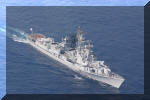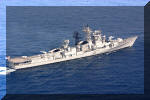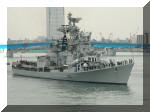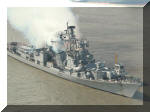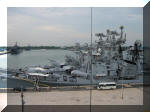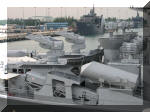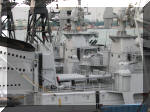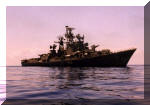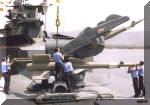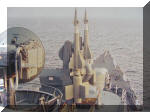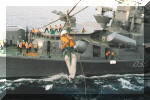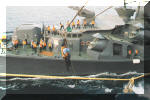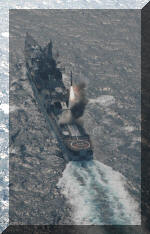Rajput (Kashin II) Class
- Details
- Category: Ships
- Published: Tuesday, 30 September 1980 00:00
- Written by Destroyer
- Hits: 70755
Vessel Type: Guided Missile Destroyer.
Names & Pennant Numbers with commission dates:
INS Rajput D51 (30 September 1980)
INS Rana D52 (28 June 1982)
INS Ranjit D53 (24 November 1983)
INS Ranvir D54 (28 October 1986)
INS Ranvijay D55 (15 January 1988)
Structure: Built as new construction for India at Nikolayev, Russia with considerable modifications to the Kashin design. The helicopter hanger has been replaced by a lift from the flight deck. The 76mm twin mount gun and the four launchers which house the P-20M (SS-N-2D Styx) AShMs are sited forward of the bridge. The BrahMos ASCM fitted on INS Rajput has replaced two of these launchers with its own boxed launchers.
Displacement: 3950 tons standard.
...................4974 tons full load.
Dimensions: Length - 147 metres.
.................Beam - 15.8 metres.
.................Draught - 5 metres.
Main Machinery: M-3E plant with four gas turbine engines developing around 60,000 hp, and two shafts.
Maximum Speed: 35 knots.
Maximum Range: 4000 miles at 18 knots.
.......................2600 miles at 30 knots.
Complement: 320 (incl. 35 Officers).
Radar: Navigation; Two 'Don Kay', I-band.
.........Air; One MP-500 Kliver (Big Net-A) radar at C-band (range - 100n miles; 183 km).
...............One Bharat RAWL (Dutch Signaal LW08) radar at D-band frequency fitted on D53.
.........Air/Surface; One MR-310U Angara (NATO: Head Net-C) radar at E-band frequency (range - 70n miles; 128 km).
..........................One EL/M-2238 STAR radar on one (or probably both) of the last two vessels.
.........Fire Control; Refer to 'Weapons' sub-section.
Sonar: Originally fitted with a hull mounted Vycheda MG 311 sonar with active search & attack with medium frequency. Also has a 'Mare Tail' variable depth sonar in active search with medium frequency. Since replaced with HUMSA during course of refits.
Weapons: Four P-20M (SS-N-2D) AShMs, in single-tube launchers, with infra-red (Mod 2) homing to 45n miles; 83 km at 0.9 Mach. Becomes a sea skimmer at the end of run. Has a 513 kg warhead. The forward P-20M missile cells (port and starboard) aboard INS Rajput have been replaced with two boxed launchers housing four PJ-10 (BrahMos) ASCMs. D51 served as the trials platform for the missile, which can be fitted with a conventional or nuclear payload of 200 kg. The missile has a range of ~300 km at 14,000 metres or 120 km at 10 to 15 metres. The missile is believed to have a first stage solid-fuelled booster and a second stage liquid-fuelled ramjet.
A pair of twin launchers is fitted with the S-125M (SA-N-1) SAM. This surface-to-air missile has a range of 17n miles; 31.5 km at Mach 2+. The missile has a 60 kg warhead weight and has a maximum altitude of 75,000 ft. The missiles, total of 44 on-board, have some surface-to-surface capability. Fire control is provided by two (NATO: Peel Group) radar at H/I-band frequency with a range of 40n miles (73 km).
One twin 76mm main gun with 80º elevation and 90 rounds/min to 8n miles; 15km with fire control provided by one (NATO: Owl Screech) radar at G-band. In the CIWS role, the first two vessels are fitted with four AK-230 30mm gunmounts with 85º elevation and 500 rounds/min to 2.7n miles; 5 km with fire control provided by two MR-104 (NATO: Drum Tilt) radar at H/I-band frequency. The third vessel had its AK-230 gunmounts replaced with four AK-630M 30mm gunmounts with an unspecified fire control director to be fitted in due course. It is possible that a BEL-developed AIO (Action Information Organisation) system will be installed. As of July 2005, no such system was visible on the vessel. The last two vessels have four AK-630M 30mm guns with 85º elevation and 3000 rounds/min to 2 km with fire control provided by two MR-123 (NATO: Bass Tilt) radar.
At refits, the last two vessels have had a pair of their AK-630M gunmounts replaced with the Barak SAM system, with fire control provided by a pair of EL/M-2221 STGR radars which replaced the MR-123 fire control radars.
circa 2008 Ranvir has been fitted with a 8 cell Brahmos VLU in place of the aft Volna-M SAM complex. First test firing of the Brahmos carried out on 08 Dec 2008. Ranvijay is being similarly upgraded.
One 533mm PTA-53-61 quintuple torpedo tube launcher is fitted amidships. Armed with the SET-65KE; anti-submarine, active & passive homing torpedo to 8.1n miles; 15 km at 40 knots with a 205 kg warhead and the Type 53-65; passive wake homing torpedo to 10.3n miles; 19 km at 45 knots with a 305 kg warhead.
Two RBU-6000 mortars with 12 tubes and a range of 6000 meters. The maximum target submarine engagement depth is 500 meters. Has a 31 kg warhead.
Helicopter Capacity: Has one helicopter pad in the aft of the vessel. The first three embark HAL Chetak helicopter in place of the Ka-25 . The last two which carriy the Ka-28 Helix-A.
Countermeasures: EW suites vary for each ship. INS Rajput has an Ajanta EW (Electronic Warfare) suite. Ranvir has SEWS V5. Some have USSR systems. Russina chaff launchers are still used.
Comments: It is possible than an Italian combat data system compatible with Selenia IPN-10 is installed. Immarsat is fitted. New EW equipment was fitted in 1993/1994. First three vessels are based at Vizag and the last pair at Mumbai. There were plans for modernization with Ukrainian assistance, but it appears that the Indian Navy has turned to Russia for help.
INS Ranjit and INS Suvarna, a Sukanya Class large patrol craft, proceeded to Mozambique on a diplomatic mission. On 25 June 2003, this pair of ships attended the 28th Independence anniversary celebrations of Mozambique and presented medicines to the Vice Minister of Health of Mozambique on board INS Suvarna. At the request of President Joaquim Chissano of Mozambique, who boarded these ships on 30 June 2003, the Indian Navy ships remained in the area to provide cover for the African Heads of States Union, which was held from 4th to 12th July 2003. They also trained the Mozambique Navy and weaved bonds of friendship during their stay.
INS Rajput served as the trials ship for the PJ-10 (BrahMos) cruise missile, which is expected to carry part of the strategic second-strike capability of the armed forces. The missile has been test fired four times - 12 February 2003, 23 November 2003, 03 November 2004 and 15 April 2005 - from INS Rajput. The last test involved a moving target, which was a decommissioned vessel of the Indian Navy. The targeted ship ended up in pieces, due to the power of the missile and its kinetic energy derived from its supersonic speed. This test was witnessed by Admiral Arun Prakash, Chief of Naval Staff; A S Pillai, Chief Executive Officer and Managing Director, BrahMos Aerospace, which manufactures the missile in India; Vice Admiral Sureesh Mehta, Deputy Chief of Naval Staff; Rear Admiral Pratap Singh Byce, Flag Officer Commanding, Western Fleet and other senior Naval officers.



